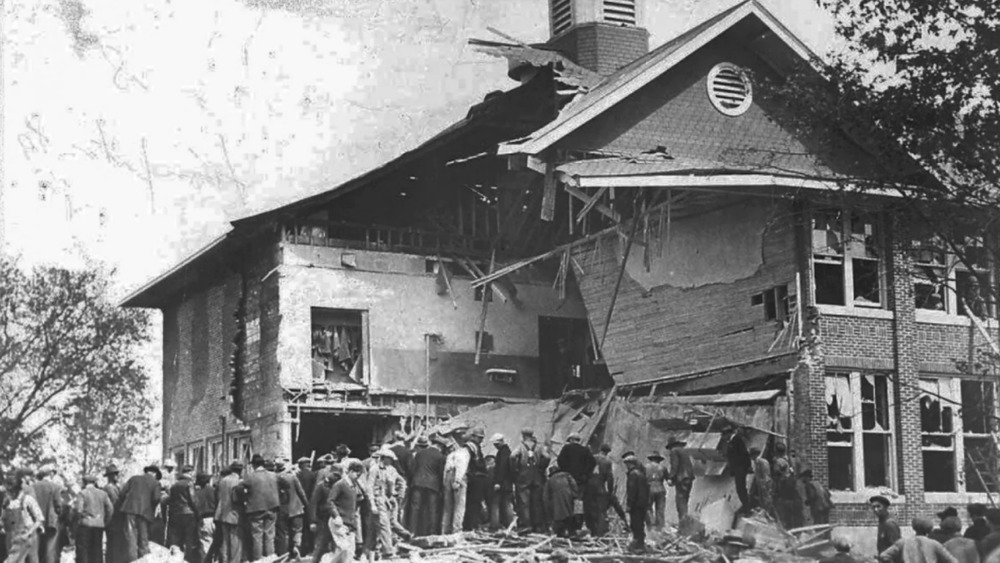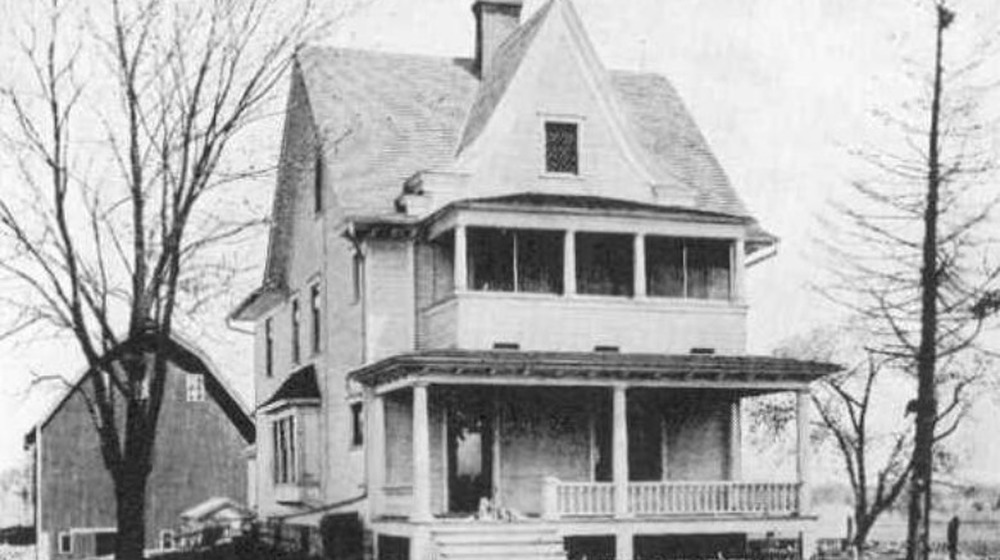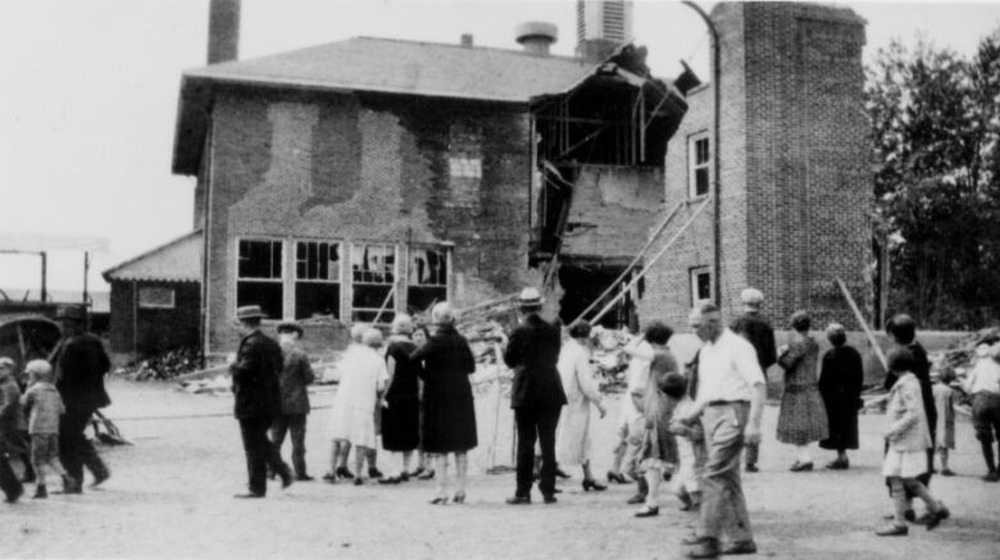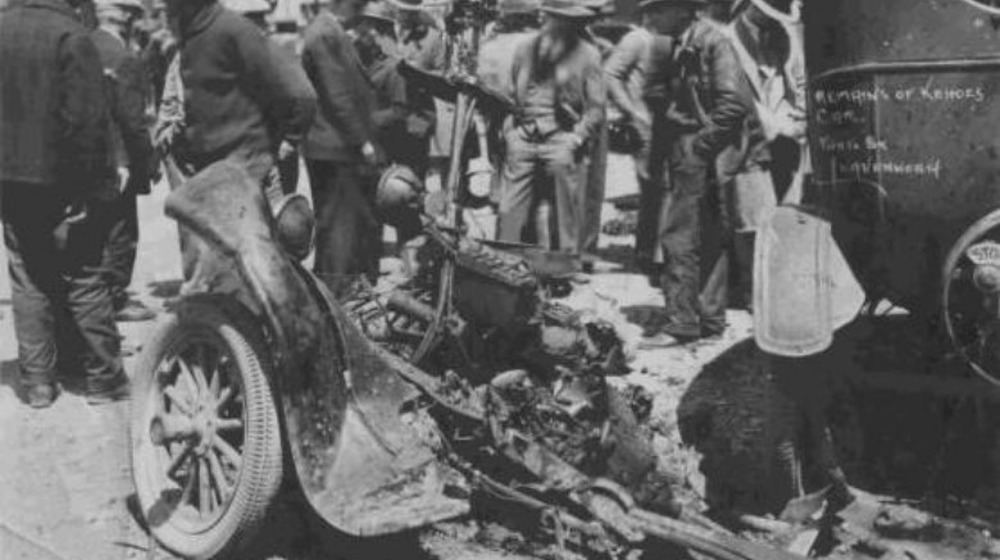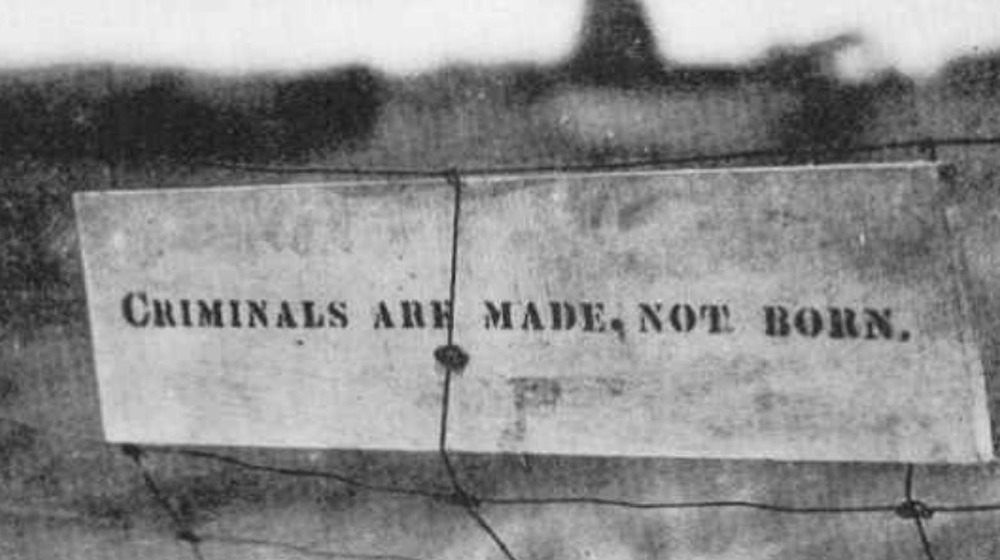The Messed Up Truth About The Bath School Disaster
Nobody in their right mind wants a school massacre to happen, but it's an unfortunate truth of the world we live in. We like to pretend that these deadly occurrences are a new phenomenon. They're not. School massacres have happened in the United States for as long as we've had schools, but as time has gone on, they've become increasingly frequent. A total of 27 people, mostly young children, died at the hands of a 20-year-old killer during the dreadful shooting at Sandy Hook Elementary in 2012. The Columbine killers claimed 13. And, older killings were just as damaging. The University of Texas Tower shooter killed 17 and injured more than 30, while the bomber of Poe Elementary in 1959 killed six, including himself and his son. But, none of these killings were as deadly as the first school bombing in United States' history.
The Bath School Disaster took place on May 18, 1927, in Bath Township, Michigan. According to Britannica, the Bath Consolidated School had opened only five years before the bombing took place. The larger school consolidated the many, scattered one-room schoolhouses in the area and served ages ranging from elementary school through high school. Thanks to the acts of one twisted individual, five years would be the entirety of this school's lifespan.
The man behind the first school-bombing in history
Andrew Kehoe is described in the same way many murderers get described after they are found out: He was just another guy. Kehoe was part of the local community in Bath Township, a small town outside of Lansing, and for the majority of his life, there didn't seem to be anything special about him. He was a Michigan State graduate with a degree in electrical engineering who everybody seemed to like. There was nothing to raise suspicion. According to Smithsonian Magazine, Kehoe was a simple farmer who lived with his wife and even served as the treasurer of the Bath school board, two facts that you'll discover are laden with a dark irony.
Somewhere around a day before the bombs went off at Bath Consolidated, Kehoe would make his first kill: his wife. Whatever happened in the day between his first murder and the bombings seem to have been lost in the decades since the massacre. On the morning of the incident, however, Kehoe hopped in his truck and headed for the school. That's when the first bomb went off, according to Britannica, destroying the buildings on Kehoe's farm. Two deadlier explosions would follow soon after.
The bomb explodes in the north wing
Just minutes after the bomb went off at Andrew Kehoe's farm, an alarm clock would trigger hundreds of pounds of pyrotol dynamite hidden below the north wing of Bath Consolidated School, according to Britannica. Being a man with hands-on skills and serving as a member of the school board had given Kehoe the perfect cover to sneak the explosives under the floorboards over the course of several months. The dynamite, which MLive says Kehoe obtained legally, didn't raise any suspicion. Dynamite was just another tool in the 1920s. Farmers would use it to clear stumps and blast holes. It was the type of thing you could pick up at hardware stores or the Farm Bureau, which coincidentally is where Kehoe obtained his.
The initial explosion leveled the north wing and did the majority of the killing. Author Monty J. Ellsworth recalls in his book, The Bath School Disaster, via Prepare and Defend, that limbs and heads could be seen sticking out from the rubble, but the plaster dust covered them so thickly, a witness couldn't make out whom they belonged to. The damage would've been worse had the second hidden explosive gone off in the school. While clearing debris, according to the Smithsonian, firefighters would discover another half-ton of pyrotol hidden beneath the south wing of the school. Kehoe didn't intend on destroying a piece of the school. He wanted to level the whole thing and take every student down with it.
A final act of mass murder
The bombs in the school weren't the end of the Bath School Disaster. When Andrew Kehoe left his farm that morning, he was heading for the Bath Consolidated. Not to see how his handy work played out, but to add to it.
The explosion from that first bomb could be heard for miles, as you'd expect from hundreds of pounds of pyrotol, and people immediately rushed to the scene to help out. Students in the south wing were mostly okay and able to leave of their own volition, but those in the north wing were trapped under literal tons of building debris. According to Smithsonian Magazine, a group of citizens was trying to remove the collapsed roof from atop the carnage when Kehoe's truck pulled up.
The back of the bomber's truck was loaded with shrapnel and another score of explosives. Kehoe grabbed a long gun and fired a single shot through the seats and into the waiting dynamite. When the truck exploded, according to Britannica, this final bang killed three adults and a child who'd managed to escape the initial blast. As the Detroit Free Press explains, the total kill count came to 44 dead plus Kehoe, who locals refuse to count in the number of victims. Of the dead, 38 were students.
Criminals are made, not born
The deeds were done and there was nothing to be done about it now, but as with any crime, there was still an investigation to be had, so naturally, the authorities went to the killer's home. Hanging from the fence outside the bomber's property, according to CLICK ON Detroit, was a sign that read: "Criminals are made, not born." MLive explains that this wasn't the only oddity found after the incident. The morning of the explosion, Andrew Kehoe shipped a same-day delivery to the school's insurance agent in Lansing. The package was enclosed in a box labeled for high explosives, but this delivery was one of few things Kehoe hadn't filled with dynamite. Instead, the package contained the accounting books Kehoe had been responsible for as school board treasurer. This was a statement.
The creation of the Bath Consolidated School had led to a substantial rise in property taxes for the township, and, according to the National Memorial to Fallen Educators, Kehoe wasn't happy about it. Kehoe's anger over the taxes and, as the Detroit Free Press mentions, losing a bid for town clerk have been cited as the "why" in the mental break that sent Kehoe down his murderous path. Yet, as Arnie Bernstein, author of Bath Massacre: America's First School Bombing, says (found via Smithsonian Magazine), "The reality is there's no why."
